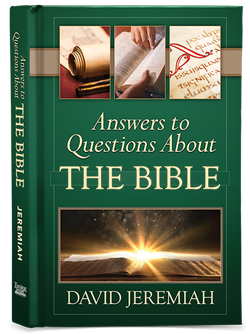Explore answers to some of the most-asked questions about Bible basics, including Who Were the Authors of the Scriptures?, and How Does the Old Testament Relate to the New Testament?, and more!
• Who Were the Authors of the Scriptures?
• What Is the Structure of the Bible?
• How Does the Old Testament Relate to the New Testament?
• What Happened Between the Old and New Testaments?
• Why Are There Chapters and Verses in the Bible?
• Why Does the Old Testament Speak of Israel and the New Testament Speak About the Church?
Who Were the Authors of the Scriptures?
The Bible was written over a span of 1,500 years by more than forty authors from all walks of life—from kings to farmers, historians to fishermen, and prophets to apostles. It was written in three languages (Hebrew, Aramaic, Greek) in four different geopolitical regions: the Middle East, Mesopotamia, Asia Minor, and southern Europe. Some books were written and edited (like Moses’ books and certain historical books), some were dictated to a scribe (Paul’s epistles), and some were the result of scholarly research (Luke and Acts). Every word of Scripture is breathed out by God, yet every word was written by a human being who was inspired by the Holy Spirit. That makes the Bible totally divine and totally human.
What Is the Structure of the Bible?
There are 39 books in the Old Testament, made up of five subgroups:
- The Pentateuch (Genesis, Exodus, Leviticus, Numbers, and Deuteronomy), contains the first five books in the Bible, which are also called “the five books of Moses” or the Torah. They span the period from Creation to Israel’s preparation to enter into the Promised Land.
- Historical Books (Joshua, Judges, Ruth, 1 and 2 Samuel, 1 and 2 Kings, 1 and 2 Chronicles, Ezra, Nehemiah, and Esther), feature twelve books that include Israel’s entry into the Promised Land, the monarchy, the destruction of Israel by Assyria and Babylon, and the Jews’ return from exile in Babylon.
- Poetic Books (Job, Psalms, Proverbs, Ecclesiastes, and Song of Solomon). These books are also called Wisdom Literature and contain collected poetry and wisdom from the psalmists and King Solomon.
- Major Prophets (Isaiah, Jeremiah, Lamentations, Ezekiel, and Daniel) are called major prophets due to the length of their book, not because the content is more important. They served an important role speaking for and following God during challenging times in the history of Israel.
- Minor Prophets (Hosea, Joel, Amos, Obadiah, Jonah, Micah, Nahum, Habakkuk, Zephaniah, Haggai, Zechariah, and Malachi). These twelve prophets delivered shorter messages in Israel prior to the northern kingdom’s destruction in 722 B.C. and after the southern kingdom’s in 586 B.C.
There are 27 books in the New Testament that include the following:
- The Gospels—these four books (Matthew, Mark, Luke, and John) introduce the New Testament chronicle of the life of Jesus and His message of the Gospel.
- Historical—the book of Acts is considered a historical book recounting the events of the Early Church.
- Epistles—there are 21 letters in the New Testament addressed to believers in developing Christian churches. They include Romans, 1 and 2 Corinthians, Galatians, Ephesians, Philippians, Colossians, 1 and 2 Thessalonians, 1 and 2 Timothy, Titus, Philemon, Hebrews, James, 1 and 2 Peter, 1, 2, and 3 John, and Jude.
- Apocalyptic Literature (Prophecy)—the book of Revelation discusses the coming Day of the Lord and the end of the present age.
How Does the Old Testament Relate to the New Testament?
Studying the Old Testament helps us understand the New Testament; the two portions of the Bible are bound together by one recurring theme: redemption. This thread of redemption through the promised Messiah runs through the Old Testament and the New Testament. Redemption, the idea of setting free or being released from bondage, is both the prevalent theme of God’s Word and the reason why the Living Word, Jesus Christ, came to earth. When Adam and Eve sinned, God’s plan to set humanity free from the power of sin through the perfect obedience of His Son was set in motion. In Genesis 3:15 we find the first revelation of this Good News, “And I will put enmity between you and the woman, and between your seed and her Seed; He shall bruise your head, and you shall bruise His heel.” Throughout the Old Testament we find glimpses of this plan, and in the New Testament we see the redemptive work of Christ’s death and resurrection in action—the greatest story ever told—the Son of God becoming a Man so that He might redeem us from our sin.
What Happened Between the Old and New Testaments?
Many significant things happened during the four hundred years between the writing of the last book in the Old Testament (Malachi) and the arrival of Jesus, the Messiah, in Matthew. This period of time is called the Intertestamental Period or the silent years. During the Babylonian exile, the Jews adopted the popular use of Aramaic, a language similar to Hebrew. Also, Alexander the Great’s defeat of the Persians occurred during this time. He liberated Greek cities from Persian rule, but now they lived under Greek rule. Greek language and customs spread throughout the region. Soon the New Testament itself would be written in Koine Greek.
During this time the Roman Empire began expanding, eventually claiming Judea and Jerusalem. Most often Roman governors ruled the country for Rome—in the Gospels we meet one of them: Pontius Pilate, the Roman ruler who ordered the crucifixion of Jesus.
During this time of occupation, the Jews longed even more for their Messiah to come and rescue them. He did not come as they expected, but when He came, His arrival changed world history forever.
Charles H. Spurgeon
Why Are There Chapters and Verses in the Bible?
When the Bible was originally written, the authors did not add chapters and verses to their writings. However, as time passed, translators began to divide Scripture for the sake of convenience. Initially the books were divided into paragraphs and then into chapters and verses.
Having chapters and verses helps us find a specific Scripture and aids us in studying and memorizing God’s Word. However, when we are studying God’s Word, it’s important to read the entire context of a section of Scripture, not just a specific verse. By doing this we are able to understand more of what the original author was saying, and we are less likely to take a Bible verse out of context or misunderstand its meaning. We should remember that the chapter and verse divisions were added by man and not inspired by God.
Receive Daily Devotions from David Jeremiah
Sign up to receive email devotions each day!
Why Does the Old Testament Speak of Israel and the New Testament Speak About the Church?
Israel is God’s chosen people, and her story begins in the Old Testament. Throughout this portion of Scripture, we learn about her history—her failings and her successes. Beginning in Genesis 12, we have the first reference to God’s plan of redemption after Adam and Eve sinned, a plan He brings about through Abraham and his descendants. In the New Testament the promised Messiah, Jesus, is born. Because of His perfect life, His death, and His resurrection, all people can be saved. The beginning of the New Testament talks specifically about Jesus’ life here on earth. The rest of the New Testament is focused on the Church and the Christian life. While Israel is still God’s chosen people and God still has a plan for her, we are currently in what we call the Church Age.

